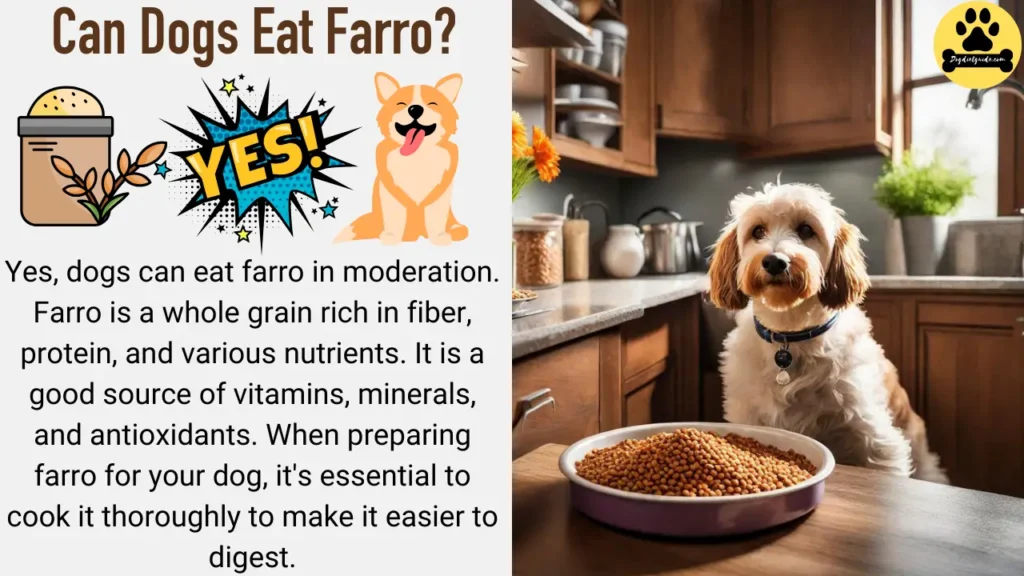In the ever-expanding realm of pet nutrition, dog owners navigate many dietary choices for their furry companions. As the quest for wholesome and balanced meals gains momentum, pet parents often seek alternative grains to diversify their canine’s diet.
One such grain that has sparked curiosity is farro. Known for its nutritional richness and versatility in human cuisine, the question arises: Can dogs eat farro?
Can Dogs Eat Farro?
Yes, dogs can eat farro in moderation. Farro is a whole grain rich in fiber, protein, and various nutrients. It is a good source of vitamins, minerals, and antioxidants for dogs. When preparing farro for your dog, it’s essential to cook it thoroughly to make it easier to digest.
Uncooked grains can be difficult for dogs to break down, and cooking helps to make the nutrients more accessible.

Nutritional Benefits of Farro for Dogs
Farro is safe for dogs and can offer several nutritional benefits for dogs with a balanced diet.
Here are some potential nutritional benefits of Farro:
-
Rich in Fiber: Farro is a good source of dietary fiber, aiding digestion and promoting gastrointestinal health in dogs.
-
Protein Content: Farro contains protein, which is essential for the maintenance and repair of tissues and overall muscle health in dogs.
-
Complex Carbohydrates: The complex carbohydrates in Farro can provide a steady release of energy, helping to sustain your dog’s energy levels over time.
-
Vitamins and Minerals: Farro contains various vitamins and minerals, including B vitamins, iron, magnesium, and zinc, contributing to overall health and well-being.
-
Antioxidants: Farro contains antioxidants that can help neutralize harmful free radicals in the body, potentially supporting your dog’s immune system.
Related Post: Is Purification Oil Safe For Dogs?
Farro Risks For Dogs
-
Allergies or Sensitivities: Some canines may be allergic or sensitive to grains. If your pup has a history of food allergies or sensitivities, monitoring for any adverse reactions such as itching, gastrointestinal upset, or other allergic symptoms is essential.
-
Digestive Issues: Uncooked or improperly cooked farro may be complex for puppies to digest. Cooking farro thoroughly is crucial to break down complex carbohydrates and make nutrients more accessible for absorption.
-
Caloric Density: Farro is relatively high in calories, and overfeeding can contribute to weight gain. It’s essential to consider your dog’s overall caloric needs and ensure that farro is given in moderation.
-
Additives and Seasonings: Avoid harmful seasonings, spices, or additives to farro when preparing it for your dog. Some herbs, such as garlic and onions, can harm canines.
-
Gastrointestinal Upset: Introducing a new food, including farro, into your dog’s diet too quickly may lead to gastrointestinal upset. Gradually incorporate small amounts into your dog’s meals to allow their digestive system to adjust.
-
Medical Conditions: Dogs with certain medical conditions, such as kidney problems or gluten intolerance, may need to avoid grains, including farro. Please consult your veterinarian to determine the most appropriate diet for your dog based on their health status.

Related Post: Are Hot Chips Safe For Dogs?
How to Safely Feed Farro to Dogs.
When offering farro to your dog, it’s crucial to do so safely. Here are some guidelines to follow:
-
Thorough Cooking: Ensure the farro is cooked thoroughly before serving it to your dog. Cooking helps break down complex carbohydrates, making it easier for your dog to digest.
-
Plain Preparation: Avoid adding seasonings, spices, or additives to the farro. Keep it plain to prevent potential harm from ingredients that may be toxic to canines.
-
Moderation is Key: Feed farro to your dog in moderation. While it offers nutritional benefits, overfeeding can lead to excess caloric intake and potential weight issues.
-
Monitor for Reactions: Monitor your dog for any signs of allergies or sensitivities. If you notice any adverse reactions, such as itching, digestive upset, or other symptoms, discontinue feeding farro and consult with your veterinarian.
-
Gradual Introduction: Introduce farro gradually into your dog’s diet, especially if it’s a new addition. This allows your furry friend digestive system to adjust, reducing the risk of gastrointestinal upset.
-
Consult Your Veterinarian: Before making significant changes to your dog’s diet, consult your veterinarian. They can provide guidance based on your dog’s health, dietary needs, and any specific considerations or concerns.
Farro Recipes for Dogs: Adding Variety to Their Plate
1. Basic Farro Meal
Ingredients:
- 1 cup cooked farro (cooled)
- 1/2 cup cooked and chopped lean meat (chicken, turkey, or beef)
- 1/4 cup cooked vegetables (e.g., carrots, peas, or green beans)
- 1 tablespoon plain Greek yogurt (optional)
Instructions:
- Cook farro according to package instructions and let it cool.
- Cook the lean meat thoroughly and chop it into small, bite-sized pieces.
- Steam or boil vegetables until soft and chop them into small pieces.
- Mix the cooked farro, meat, and vegetables in a bowl.
- Optionally, add a tablespoon of plain Greek yogurt for added flavor and probiotics.
- Serve a suitable portion based on your dog’s size and dietary needs.
2. Farro and Pumpkin Treats
Ingredients:
- 1 cup cooked farro (cooled)
- 1/2 cup canned pumpkin (make sure it’s plain pumpkin puree without additives)
- 1 egg
- 1/4 cup rolled oats
Instructions:
- Preheat your oven to 350°F (175°C).
- Mix the cooked farro, canned pumpkin, egg, and rolled oats in a bowl.
- Scoop spoonfuls of the mixture onto a baking sheet lined with parchment paper, forming small treats.
- Bake in the preheated oven for about 15-20 minutes or until the treats are firm.
- Allow the treats to cool completely before serving.
Final Thoughts: Can Dogs Eat Farro?
In conclusion, while Farro offers notable nutritional benefits for dogs, it’s essential to approach dietary changes with care. Striking the right balance and paying attention to your dog’s needs will ensure a happy and healthy companion.




![Can Dogs Eat Blood? 7 Side Effects [Expert Opinion]](https://petskor.com/wp-content/uploads/2022/04/Webp.net-resizeimage-12.jpg)
